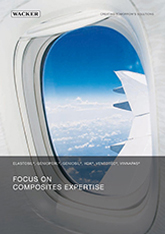Our system has noticed that you are based in United States, but the current country setting is Germany. Do you still want to change your country?
- Home
- Products & Services
- Applications
- Composites
- Composite Molding
Composite molding

Fiber-reinforced composite materials have changed the world thanks to outstanding technical properties such as low weight and resistance to corrosion.
Silicone rubber plays an important role in making composite molding processes efficient, sustainable and economical.

Suitable for frequent reuse: bags (approx. 4 x 3 m) can be rolled up for transport and reused many times. The bag shown here has already been used over 250 times.
Silicone vacuum bags can made from two-part ELASTOSIL® silicone rubber and reinforcing fabric using either brushing or spray techniques.
These vacuum bags can then be placed quickly and reliably on the production mold, thus eliminating the time-consuming, repetitive process of sealing the mold with vacuum film and tape. Bags made from ELASTOSIL®silicone rubber make production more efficient and yield reproducible quality.
Even sealing profiles and the resin infusion system itself (port and channels) can be molded from silicone rubber within an overall vacuum bag system. Resin infusion systems made of silicone rubber are also compatible with film/tape technology.
Advantages of vacuum bag technology
- Shorter production cycles
- Less outgassing
- Less waste
- Less labor intensive
Advantages of ELASTOSIL®:
- Flexible
- Self-leveling
- Longer pot life and curing time
- Suitable for large surfaces
- Suitable for vertical surfaces
- Reusable
“Trapped-rubber molding” methods – approaches utilizing thermal expansion, in other words – are composite molding techniques in which a prefabricated, flexible silicone mandrel is placed in a closed, rigid cavity/container. The composite material is positioned within this mold structure, and thermal expansion causes the silicone rubber to press the material against the container walls in the mold.
Advantages of ELASTOSIL® M silicone rubber:
- Elasticity
- Good release properties
- Heat resistance
- Suitable coefficient of thermal expansion
Silicone rubber pressure intensifiers and spacers are important tools in composite molding: on the one hand they can be used as bellows or wedges delivering the right pressure at the right point in the composite production process.
They also serve as spacers for molding hollow structures in a composite part. Reusable silicone rubber spacers are used, for example, for molding precise, consistent cavities in the rotor blades of wind turbines.
Advantages of ELASTOSIL® and CENUSIL® silicone rubber:
- Elasticity for easy demolding
- Good release properties
- Reusability: can be used for many production cycles
- Chemical resistance








